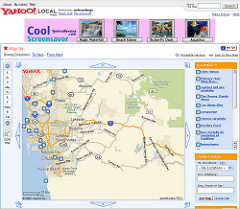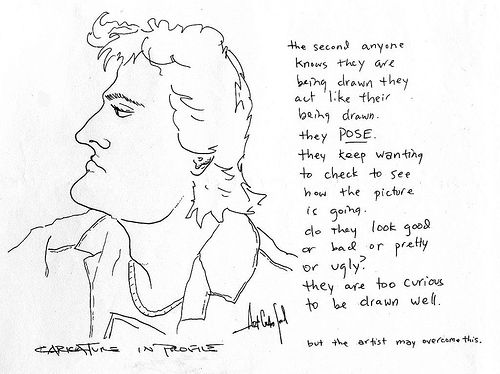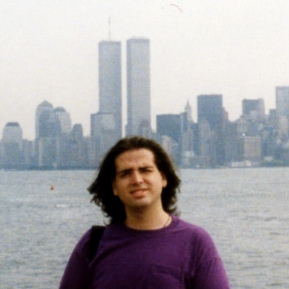Check San Diego Blog for some news about some interesting work I did porting the geodata of the San Diego Bloggers sites into maps powered by Google Maps API and Yahoo!Maps API.
June 2005 Fifty-two posts
-
Portrait, Design Class, 1988
Aside:
So I got the gift of a flickr pro account from Steve Agalloco. This post is the first of many where I take advantage of the 2 Giga with a “G,” Gigabyte per month upload limit. Profuse thanks Steve, for this wondrous gift!As my first post using this, here’s an image that really is not done justice by my self-imposed 400 pixels wide image dimensions limit. If you click over, you can see there’s a button that says “all sizes” so you can see it at much higher resolution.
So in 1988 I was taking a Design class at San Diego Mesa College. I was kind of a lost soul at that point, educationally and professionally. See, I didn’t apply to any colleges. Not that I could not have been admitted to colleges, just, well, I thought somehow I could put it off. I think I was probably giving the impression of a kid who had some college plans… like maybe Art Center, maybe Pepperdine, maybe SDSU, maybe UCSD — but the reality was that I had read about colleges and I just thought… what’s the point?
Not that I didn’t have ambitions, I think I did. I wanted to be an artist or perhaps work in advertising or something. But really, I was aimless and naive about my future. Somehow, eventually, it all worked out more or less. I mean, 19 years on it all seems to have worked out: several moves, an associate degree, some medical licenses, two careers, a dozen jobs, the high of the dot com boom, the internet, a marriage, a divorce, the crash of the dot com boom, a new partner, another move, and kids.
I’m a much happier and more self-aware person than these previous versions of myself. This is the lesson of my life. Go towards good things, and be fearless in examining yourself, even the distasteful parts.
But I digress.
So this design class was kind of interesting. I was pretty cocky. I had been doing design for what felt like a long time. I had made flyers for friends and family for years. I thought I knew a lot. This quality does not make for a good student. If you think you know more than your teacher, you doom yourself to not really learning very much from your teacher. This is unfortunate. The the instructor being a hyperactive, hippie slash new-agey lady with these big square glasses. Her knowledge of design history and art history was weak. There were a few times I and others would correct her on some issues. In hindsight I think I was kind of a jerk about it.
The through line of this story is “Joe did not listen, and so Joe did not do well.” I did mediocre on my projects for this class. I did shoddy work.
It’s so strange to think now, that this design class was all analog. X-acto knives, T-squares, frisket, pen and pencil and paper. Nary a computer, or even a mention of computers. This was 1988, and the desktop publishing revolution was beginning. I had been exposed to Macintosh computers while working at Citizen’s Western Bank, but it was really a toy, not used to do serious work. And quality printing from a computer was really an oddity.
One could get a color copy made, but it was expensive. I remember spending $8 for a single color copy of an 8-1/2” by 11” sheet of paper, and the quality was not very good.
I digress again.
It’s no fun to look at the laziness and hubris of my eighteen year-old self. I suppose some of those qualities stay with me. I like to think I have learned about those tendencies and learned to take them head on.
Life’s a learning process.
I got a C in that design class.
But I think I learned a lot from it. Not about design, but about myself.
Hindsight is great, isn’t it?
Oh, the drawing? You’re wondering perhaps about the drawing itself? Well, it’s a caricature and a portrait. As I look at it, I think, yes, that’s exactly what the guy looked like. And yet it’s subtly exaggerated too. I love the little monologue on the side there — “but the artist may overcome this.” And the way I sign it, with my middle name “Art” — I had a giant 18-year-old head of ego in there.
I used to draw a lot in that class. I always had a giant notebook, really a large size sketchbook, that I took notes in. I took great notes, which is odd because I didn’t care for the class. I was always a good note-taker. But the ego and the sloth really got the best of me.
-
Roanoke House, 1991
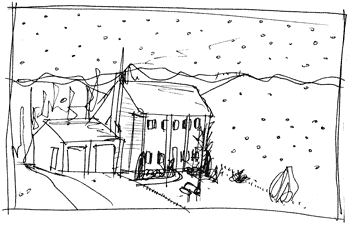
This was a study for a possible Christmas card I was going to make. A caricature of our house in Roanoke while it was snowing. Very quick, very rough.
This is the kind of drawing I really enjoy doing.
-
Cyberpunk Guy, 1988

When I was a sophomore in high school I had a friend named Jason Erwin. He was an oddball, computer nerd, and geek. I distinctly remember being driven to see The Adventures of Buckaroo Banzai with him. He was cool.
I don’t remember what the debt was, but in return for some debt from him I got a copy of the book Neuromancer, by William Gibson. This would’ve been 1983 or 1984.
Whatever the original debt was, it was worth it. The paperback blew me away. It was this strange world, it was a “dystopia,” a word which I didn’t yet know. It had this “net,” this “cyberspace,” that was completely ubiquitous. It felt like the future.
I wanted to sign up for a cranial jack. I wanted to wear leather and have implanted memories, to “jack” into cyberspace and experience the combined space that constituted the collected sum of the computing space from the whole human system.
It’s strange that I wanted this. The characters in Neuromancer are corrupt, venal, unlikable. I suppose Molly Millions and Case are likable, but they are also rather pathetic. Case is a junkie who is forced to give up drugs chemically, and gets his high simply by making “runs,” basically hacking jobs, on the net. And Molly is an assassin for hire.
I suppose The Dixie Flatline is the most likable “person” we meet, although he himself is an old hacker whose mind was imprinted into a box. Dixie is actually dead, and what we know of him is just the remnants of his mind that were flash loaded into a ROM. Dixie is helpful and wise, but his one ambition is that at the end of the gig, that someone wipe his memory. He’s not alive, but he wants to commit suicide.
I suppose Wintermute is a likable, the deux ex machina, an A.I. that has gotten smarter and at the end is a Vingean Singularity, an intelligence, a consciousness, beyond human understanding. Wintermute becomes a god.
So if it’s not the characters, what was it that compelled me about this book? I had always enjoyed science fiction, probably since Star Wars. I also vaguely remember conversations with a roommate, a friend of my dad’s, who had science fiction, and who once explained the importance of the difference between “SF” and “Sci Fi.” I was 8 or 9 years old and it made an impression.
The question remains, why was I fascinated by Neuromancer, and by extension, cyberpunk as a genre? Why did Blade Runner and Snow Crash and Islands in the Net make such an impression on me?
I don’t have an easy answer.
One possibility is that it was a reaction to the postnuclear scenarios popular at the time. Mad Max and The Road Warrior were dystopias too, but they were ones where human beings managed to royally screw up the planet with nuclear weapons. It’s hard to remember, but I always assumed that before the end of the 20th Century, we’d have a nuclear weapon used in anger. I mean, we took it for granted that we’d get blown up. Or, if not blown up, we’d have to be running around in dune buggies with shotguns struggling for gasoline.
Cyberpunk was a future in which, well, we’re there, somehow. In 1989 I recorded a William Gibson interview on Fresh Air, and as he says:
“Well that’s a very optimistic little piece of trickery on my part because I wanted to be able to write about a future, and I wanted to be able to say ‘Well it’s there.’ So I posited as a piece of background information one very, very brief nuclear exchange that results in the whole world saying ‘Oh no we’ve got to get rid of these things’ and then it’s, you have a future. But we should be so lucky, probably.”
How’s that for optimistic? At the time, and heck, even now, this feels plausible. A nuke or dozen get used, people say “This technology sucks! We’d rather use economic/conventional/chemical/biological war. Anything but these stupid Chernobyl radioactive things!” Then, as Gibson says, you have a future.
And I definitely wanted a future. I had no idea what shape it would take, but I wanted one.
Anyway, so that’s how I end up with a drawing of a guy with wild hair, a computer input jack on the side of his neck, and a biker jacket.
Possibly this description, also from the Terry Gross interview, influenced me:
Terry Gross: “Well your books have added a word to the language in a way your books have been named “cyberpunk,” what do you think of that new word?”
William Gibson: “Well, that’s one I could’ve done without but that’s a very mysterious word, we’re still trying to find out who introduced it. It definitely wasn’t one of the participants in this alleged literary movement, or phenomena or whatever it is. But I suppose in a way, it’s reasonably descriptive, although I don’t know what people would think of it when they see it, I mean if I didn’t know what it was supposed to mean, I would think it would mean some guy in a mohawk, it’s like modems and mohawks, or something. A guy with a mohawk and a mac. A mac II, and though, I don’t know, that wasn’t what I had in mind I just thought, when I started out doing this stuff I thought I was trying to do what I thought of as being a slightly hipper kind of science fiction.”
And that’s all I have to say about that.
Tom linked to me with the phrase “kick ass.” I can do the same thing right back at him. Heh. “kick ass“
-
Estero Beach Wooden Fish, 1993
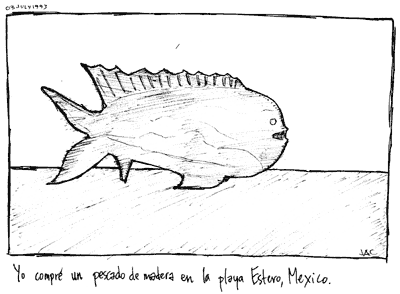
From my journals. An illustration of a wooden fish I bought on the beach at Estero, in Baja California.
We were staying at the cheap campground on the resort, waverunning and such. I haggled and got what seemed like a good price. I think I gave it away as a gift, but I honestly can’t remember.
Estero Beach now has a website: www.hotelesterobeach.com — yeah, we stayed in the RV campground. I’d stay there again. It was a good time. I went there with my aunt, my uncle, and my sister.
This was the time when I was the most scared of dying. I got thrown off the waverunner in heavy surf and could not get back on. I was a few hundred yards offshore, the surf was high, and I could not see anyone, onshore or offshore. Utterly alone, awkward, and tired, I struggled for quite a while, thinking I was doomed to die.
Well, I didn’t die, and the waverunning was pretty awesome.
-
Dwayne the Bear, 1990

Another invented character. I like him, but he really does not have much of a personality beyond looking lanky and bemused.
Great name though.
-
Dead Man, 1997
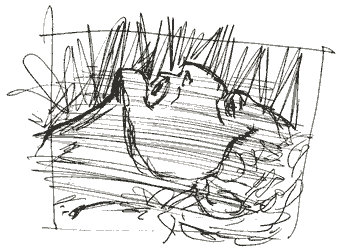
In 1997, I was still working as a Respiratory Therapist. I was working at a hospital in downtown Los Angeles.
So this is an image of a man I was going to be giving a treatment to.
Instead, I discovered the man was not breathing, and was pulseless. He was dead.
I don’t know how long he was dead, but I called a code blue, the code team assembled and tried to revive him, and after we had done those mechanical procedures, he was declared dead and we moved on.
It was not a busy night, so I cleaned up the oxygen equipment and resuscitation bags and miscellaneous respiratory therapy gear. The nurses removed his IV lines and miscellaneous room items. They assembled his personal items for retrieval by next-of-kin.
I took two minutes and drew this dead man on the back of my assignment sheet. A few quick strokes of the pen on a laser printout capturing the last image made of a man.
It’s strange to me to see this drawing, because it takes my mind back to the moment when I found him, and calling the code, and working on him, “breathing” for him.
My work no longer involves coming across dead men in the night, or breathing for them, or comforting the sick.
Sometimes I miss that work, but then sometimes I don’t, either.
It’s a tricky thing to work with death and dying on a day-to-day basis. It’s invigorating, yet draining.
I may not ever work in respiratory therapy ever again, but there is wiring in my brain for doing that job that won’t go away: call the code, check pulse, check respirations, secure the airway, ventilate, begin chest compressions, prepare the chest for shock, shock at 200 joules, check for a pulse…
The wiring may have cobwebs on it, but it’s still there. Some archetypal version of “Clinician Joe” hidden in there.
When I started scanning these drawings I had no idea where it might take me. I certainly never expected to find drawings from work, but the truth is I think I have lots of little drawings from when I worked at the hospital.
So we’ll see where they take me.
Onward.
-
Jaycees
Some people I share the initials “J.C” with. I had this on paper from over 10 years ago. I’m throwing out the list, and blogging it:
- Jack Cade
- Jack Cole
- Jacques-Yves Cousteau
- James Chadwick
- James Cook
- James Crichton
- James Cabell
- Jesus Christ
- John Cabot
- John Calvin
- John Carver
- John Cheever
- John Colet
- John Chapman aka “Johnny Appleseed”
- Johnny Cochran
- Joseph Cannon
- Joseph Conrad
- Julius Ceasar
*And two Cee-Jays:*
More about the Jaycees aka “United States Junior Chamber”
This is an utterly useless post. I hope you enjoyed it.
-
Abstract Composition, 1987

A cartoony abstract.
There’s a dialogue between the two men — the abstract man front and center, and the seemingly skeptical man on the right hand side.
I was decidedly ambivalent about abstraction in my own work. It was enjoyable, but I wasn’t quite sure it was _relevant_ in any way to anything I was doing.
I love abstraction now, Leah‘s work is abstract, for example. Then, as now, I admire Pollock and Miró as well. That said, I also love some powerful realism as in Alex Grey, and of course the painters of the Renaissance.
The tension between these tastes is satisfied in my enjoyment of Salvador Dali, who was abstract, realistic, and surreal, in addition to having a ravenous taste for fame and media presentation.
What was I talking about? Oh, art.
That must be why I digressed.


